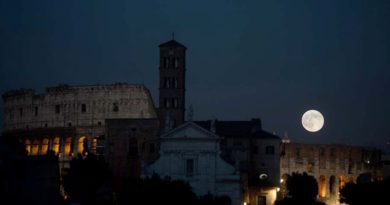Gerard Mercator
Il 5 marzo 1512 nasceva nelle Fiandre Gerardus Mercator. Google gli dedica il doodle di oggi.
Sul lavoro e sulla figura di Mercatore è stato pubblicato nel 2004 da Mark Monmonier il volume
Rhumb Lines and Map Wars: A Social History of the Mercator Projection dal quale pubblichiamo un estratto.
Gerard Mercator was more than just a mapmaker. Although biographical dictionaries accustomed to single occupations typically treat him as merely a cartographer or a geographer, Mercator distinguished himself at various times as a calligrapher, an engraver, a maker of scientific instruments, and a publisher. No less impressive are his deep interests in mathematics, astronomy, cosmography, terrestrial magnetism, history, philosophy, and theology. Although biographers lament the lack of diaries, account books, and carefully archived personal correspondence, the historical record reveals Mercator as an introspective and energetic chap who was competent in science, honest and well liked, technically savvy and clever with his hands, curious about the world around him, successful as an entrepreneur, and well positioned to make a pair of substantial contributions to mapmaking.Mercator’s first biographer was Walter Ghim, his neighbor in Duisburg, the small German city where he lived from 1552 until his death in 1594. A twelve-term mayor of the town, Ghim contributed a short biography to the 1595 edition of Mercator’s Atlas, published posthumously by his youngest son, Rumold. Ghim’s essay is more a long obituary than a critical biography. The mayor praises Mercator as a “remarkable and distinguished man,” notes his “mild character and honest way of life,” and provides dates and other details for key events in the cartographer’s career. Thus we learn that Gerard Mercator was born at approximately 6 a.m. on March 5, 1512, in Rupelmonde, Flanders, where his parents Hubert and Emerentiana were visiting Hubert’s brother, Gisbert Mercator, “the energetic priest of that city.” (Flanders is roughly coincident with the northern part of present-day Belgium, and as figure 3.1 shows, the village of Rupelmonde is about ten miles southwest of Antwerp.) He died “82 years, 37 weeks, and 6 hours” later—a remarkably long life for the sixteenth century—after coping in his final years with partial paralysis and a cerebral hemorrhage. Ghim offers a detailed description of Mercator’s failing health and last rites but says little about the mapmaker’s early life.
Scholarly interpretations of sixteenth-century Flanders helped historian of calligraphy Arthur Osley paint a richer picture. Although Mercator’s parents had little money—his father was a shoemaker and small farmer—Gisbert was at least better connected. Through his uncle’s influence, Gerard was enrolled at age fifteen in the distinguished monastic school at ’s-Hertogenbosch run by the Brethren of the Common Life, who accepted poor but bright boys willing to train for the priesthood. The brothers specialized in copying sacred texts, and their school excelled at teaching penmanship. In addition to learning Christian theology and Latin, Mercator developed a practical and lasting interest in the elegant italic script in which he engraved place names and interpretative text for his maps. He considered italic lettering more appropriate for scholarly writing than Gothic and other less formal (and often less legible) styles of handwriting, and in 1540 he published Literarum latinarum, quas Italicas cursoriasque vocant, scribendarum ratio (How to Write the Latin Letters Which They Call Italic or Cursive), a short manual that was influential in the adoption of italic lettering in cartography.
Various renderings of Mercator’s name invite confusion. Although his German father apparently went by Hubert Cremer, vernacular versions of the family name include de Cremer, Kramer, and Kremer. Krämer (the modern spelling) is the German word for merchant or shopkeeper, Cremer is its Dutch equivalent, and Mercator is the Latin version, which the future mapmaker adopted at ’s-Hertogenbosch. (Latin was the language of Europe’s educated elite, and young scholars routinely latinized their names.) Although Gerhard Cremer and Gerardus (or Gerhardus) Mercator might be more historically correct, American and British cartographic historians prefer the partly anglicized Gerard Mercator. A reasonable compromise, I’m sure, as an obsessive purist would need to write awkwardly about Gerardus Mercator Rupelmundanus (Gerard Mercator of Rupelmonde), the name under which Mercator enrolled at the University of Louvain in 1530 and published his epic world atlas. At Louvain Mercator studied humanities and philosophy, attended lectures by the brilliant mathematician and astronomer Gemma Frisius (1508-55), and received a master’s degree in 1532. With his religious faith challenged by contradictions between biblical accounts of creation and Aristotle’s writings, Mercator occasionally felt stifled at Louvain, where doubt was akin to heresy. He began corresponding with a group of Franciscan preachers living in Antwerp and Mechelen (see fig. 3.1), and visited them several times to discuss theology and science. His confidants included Franciscus Monachus (ca. 1490-1565), a prominent geographer who produced a terrestrial globe around 1520 and is a plausible source of Mercator’s knowledge of northern lands. Although his absences from Louvain aroused suspicion, Mercator eventually resolved his concerns over the conflicting interpretations and, according to Osley, “emerged with strong Christian convictions, which remained with him.” Reluctant to leave Louvain, Mercator pursued an academic apprenticeship centuries before the modern university gave us postgraduate education. In addition to convincing Frisius to instruct him in astronomy and geography, Mercator and his tutor persuaded Gaspar van der Heyden, a local goldsmith and engraver, to let Mercator use his workshop for making globes and scientific instruments. The three apparently collaborated on numerous projects, including maps and surgical instruments—Frisius was also a physician—and the future mapmaker either contributed to or witnessed all phases, from design to marketing. As Osley observes, by age twenty-four Mercator had become “a superb engraver, an outstanding calligrapher, and one of the leading scientific instrument makers of his time.” And as his later works attest, skill in engraving gradations and labels on brass and copper instruments proved useful in making printing plates for maps and globe gores. An energetic learner, Mercator progressed quickly from globes to flat maps and from engraving to full authorship. In 1536 he engraved the italic lettering for Frisius’s terrestrial globe, which was assembled by pasting twelve printed gores onto a spherical papier-mché shell nearly 15 inches (37 cm) in diameter. His role expanded from engraver to coauthor with the publication a year later of Frisius’s celestial globe, similar in size and manufacture. In 1537 he also authored and published his own map, a 17 by 39 inch (43 by 98 cm) cartographic portrait of Palestine engraved on copper and printed as six sheets, which formed a wall-size map when glued together. Mercator’s enduring interest in religion was no doubt a key motivation. Although he cites Jacob Zeigler as his principal source, the small map included with Zeigler’s book on the Holy Land, published five years earlier, is comparatively sketchy. Cartographic historian Robert Karrow, who labeled the map a “commercial success,” notes that it remained in print for at least four decades and provided the geographic details for Palestine for Mercator’s epic world map of 1569.
In 1538 Mercator published a 14 by 21 inch (36 by 55 cm) world map, laid down on the double cordiform (double heart-shaped) projection (fig. 3.2) pioneered in 1531 by the French mathematician Oronce Fine (1494-1555). Although Mercator borrowed the geographic framework from Fine, his map is more similar in content to Frisius’s terrestrial globe. As close examination of its features and place names reveals, he consulted additional sources but was the first to identify North and South America as separate continents. Also noteworthy are the suggestion of a Northwest Passage and the separation of Asia and North America, typically attached on early-sixteenth-century world maps. Aware of the uncertainty of some delineations, he scrupulously differentiated known, previously mapped coastlines from their more speculative counterparts in areas largely unexplored.
Mercator’s next publication was a detailed 34 by 46 inch (87 by 117 cm) map of Flanders, printed as four sheets in 1540. Prepared at the urging of Flemish merchants, the map was based on precise trigonometric and field surveys. Although some historians attribute the measurements to Mercator, who no doubt engraved the copper plates, others question whether the impoverished artisan had the time and resources for extensive fieldwork during the harsh winters of 1537-38 and 1539-40. A key skeptic is Rolf Kirmse, who observed that the distances portrayed are off by only 3.4 percent on average and that the average error of the angles is a mere 2° 20′. According to Kirmse, the timing of the surveys and their high level of accuracy point to Jacob van Deventer (ca. 1500-1575), a Dutch mapmaker who lived in Mechelen in the late 1530s and later produced a unique collection of town plans of the Netherlands for the king of Spain. Whoever the surveyor, there is no dispute about the map’s success and influence. Among the fifteen subsequent editions published between 1555 and 1594 is a smaller adaptation included in the 1570 world atlas by Abraham Ortelius (1527-98), a genial contemporary of Mercator. In August 1536 Mercator married Barbara Schellekens, and the following year Barbara gave birth to their first son, Arnold. The couple eventually had six children, three boys and three girls. All three sons became mapmakers for a time at least, and Rumold (ca. 1541-1600), their youngest, became his father’s representative in England and supervised publication of the first complete edition of the Mercator world atlas. Although prosperous and comparatively erudite, sixteenth-century Flanders was frequently engulfed in conflict between Protestant reformers and Catholic traditionalists, who in 1544 began a brutal effort to suppress Protestantism. Mercator’s letters to the friars in Mechelen as well as his more recent travels attracted the attention of religious extremists, who imprisoned him at Rupelmonde in March 1544. The zealots also held forty-two other suspects, including Joannes Drosius, to whom Mercator had dedicated his 1538 world map. Although protests by the mapmaker’s friends, colleagues, town officials, and a local priest won his release seven months later for lack of evidence, four of his fellow detainees were beheaded, burned at the stake, or buried alive. Mercator’s religion remains ambiguous. Some writers consider him a Protestant (possibly a Lutheran convert), while others insist he remained a committed Catholic. Ghim and Osley ignore the mapmaker’s church affiliation altogether, Karrow confesses uncertainty, and the late Richard Westfall, who compiled the entry on Mercator for the Catalog of the Scientific Community Web site, emphatically states, “I find it impossible to tell.” Mercator was released from his imprisonment into Catholic territory, Westfall notes, but eight years later he left Louvain for Duisburg, in Cleve (a German duchy about fifty miles east of Flanders), which was Protestant. Even so, Catholic patrons continued to sponsor his projects and buy his maps. Although religious unrest or outright persecution might have precipitated the move, the immediate incentive was a job offer from William, Duke of Cleve, who planned to open a university in Duisburg. Although the duke’s academy never developed, royal and commercial patrons continued to underwrite Mercator’s globes, maps, and scientific instruments. Especially significant is his 1554 map of Europe, which he started in Louvain. Engraved in copper and printed as fifteen separate sheets, the entire map measures 47 by 58 inches (120 by 147 cm) and, according to the ever enthusiastic Walter Ghim, a revised edition published in 1572 “attracted more praise from scholars everywhere than any similar geographical work which has ever been brought out.” The 1554 edition’s portrayal of Britain underscores the difficulty of obtaining accurate geographic information about a country that feared invasion. According to Peter Barber, the British Library’s expert in medieval and early modern maps, Mercator relied heavily on existing maps, including a 1546 map of England published in Rome by George Lily, as well as reports from various unnamed correspondents, including the British astronomer-mathematician John Dee, who lived in Louvain from 1538 to 1540. Although his correspondents helped him add place names and refine coastlines, Mercator’s treatment does not mirror the markedly more accurate geometry of unpublished British surveys of the late 1540s and early 1550s. More surprising is the omission of several bishoprics that Henry VIII had established after he broke with Rome—surprising because Mercator, now living in Duisburg, had little to fear from church authorities. In Barber’s view, the omission reflects either ignorance of the bishoprics or a reluctance to antagonize a generous supporter, Cardinal Grenvelle, to whom Mercator dedicated the map. More impressively accurate is Mercator’s 1564 map of England, Scotland, and Ireland, printed on eight sheets, which compose a 35 by 50 inch (88 by 127 cm) wall map. A curious inscription attributes its content to a prototype mysteriously acquired from an anonymous acquaintance. According to Ghim, “a distinguished friend sent Mercator from England a map of the British Isles, which he had compiled with immense industry and the utmost accuracy, with a request that he should engrave it.” Neither Mercator nor Ghim named the source, whose identity sparked the curiosity of map historians who, as Barber tells it, eagerly enlisted in a game of “find the friend.” After analyzing place names, shapes, and other details together and carefully assessing information available to plausible informants, Barber attributed the draft to John Elder, a Scottish Catholic who traveled freely between England and mainland Europe. Elder had access to the Royal Library, where he apparently compiled the map from ostensibly top-secret drawings by English surveyors. According to Barber’s hypothesis, Elder left England in late 1561, amid growing hostility between the Catholic and Protestant supporters of Mary Stuart and Elizabeth I, and gave the map to Cardinal de Lorraine, who persuaded Mercator to make the engraving. Although powerful patrons like the Cardinal no doubt initiated specific projects, serendipitous influences were at least equally important. For example, Mercator’s famous 1569 world map, discussed in greater detail in the next chapter, was at least partly encouraged by his appointment to teach mathematics, as a part-time volunteer, in the gymnasium (high school) established by Duisburg’s city council in 1559. Mercator designed a three-year course that included geometry, surveying, and mathematical astronomy, and he taught the entire sequence once before surrendering the position to his second son, Bartholomew. A second example is his appointment around 1564 as cosmographer to the Duke of Jlich, Cleve, and Berg. According to Karrow, this nomination inspired Mercator to plan an enormous series of works on geography, cosmography, and history. The first part to be published was the Chronology (1569), an attempt to establish an accurate framework for world history. The Chronology included tables of solar and lunar eclipses and a conscientiously researched chronological list of political, cultural, scientific, and biblical events. Committed to completeness, Mercator earned a place on the Church’s list of banned books by including events associated with Martin Luther and a few other heretics. As a second installment of his vast, comprehensive work, Mercator published an authentic version of Ptolemy’s Geography,deliberately devoid of the distracting interpretations and misinterpretations by earlier editors intent on improving the Egyptian geographer’s seminal work. Mercator’s goal was an accurate portrait of Ptolemy’s second-century view of the world. To understand the present, the mapmaker believed, one must appreciate the past. The atlas, published in 1578, included Ptolemy’s twenty-seven maps, carefully restored, handsomely engraved, and supplemented by an index of place names and an enlarged boundary map of the Nile Delta. The maps vary slightly in size, with the typical display measuring approximately 13 by 18 inches (34 by 46 cm). Seven subsequent editions, published between 1584 and 1730, attest to the book’s importance to scholars. An engraved portrait of Mercator holding a globe and dividers (fig. 3.3) suggests that the mapmaker, now in his seventies, had become a brand name in geographic publishing.
While working on Ptolemy’s Geography, Mercator had started to compile maps for his celebrated world atlas, which would provide the modern geographical component of the massive treatise he envisioned. Resolving discrepancies between sources and engraving most of the plates himself was a slow process, especially for a seventy-year-old mapmaker. Trading off delay and fragmentation, he published Atlas sive Cosmographi Meditationes de Fabrica Mundi et Fabricati Figura (Atlas, or Cosmographic Meditations on the Fabric of the World and the Figure of the Fabrick’d) in three installments: a 1585 edition, with 51 maps focused largely on France, Germany, and the Low Countries; a 1589 volume, with 23 maps taking in Italy and Greece; and the complete, 1595 edition, which reprinted the 74 maps issued earlier and added 28 new maps covering most of the remaining parts of Europe. Because the atlas lacks detailed maps of Spain and Portugal, “complete” is misleading. Mercator no doubt desired a more comprehensive treatment of Europe, but time was running out. Weakened by strokes in 1590 and 1593, he died on December 2, 1594, leaving completion to his son Rumold and grandsons Gerard, Johann, and Michael. In addition to supervising printing, Rumold authored a world map and a regional map of Europe, Gerard signed regional maps of Africa and Asia, and Michael contributed a map of America. The project also provided employment for local artisans, who hand-colored the maps. Like other mapmakers, Mercator relied on colorists, mostly women, to enhance his otherwise bland line engravings. What took so long? The late Clara LeGear, an atlas authority at the U.S. Library of Congress, identified four impediments: Mercator’s need to support himself with other projects, the difficulty of obtaining reliable geographic details, the slow pace of meticulous map engraving, and a shortage of skilled copperplate engravers. Mercator not only compiled all the maps for the atlas but also engraved the printing plates, with only occasional help from his grandson Johann and Frans Hogenberg, a skilled artisan who engraved most of the seventy maps for Theatrum Orbis Terrarum (Theater of the Whole World), published in 1570 by Abraham Ortelius, a publisher and map seller living in Antwerp. Although a competitor, Ortelius was also a close friend of Mercator. So close, according to Walter Ghim, that Mercator deliberately delayed his own atlas. As Ghim tells it, Mercator “had drawn up a considerable number of models with his pen” and could easily have had them engraved. Yet he held up publication until Ortelius “had sold a large quantity of Theatrum…and had subsequently increased his fortune with the profits from it.” A nice story, perhaps, but the tedium of map engraving as well as the fifteen years between Theatrum and the first installment of Mercator’s Atlas suggests Ghim was spinning a yarn. In pioneering the notion of a consciously organized book of mainly maps with a standard format printed in uniform editions of several hundred copies, Ortelius has a stronger claim than Mercator to the title Father of the Modern World Atlas. According to map historian Jim Ackerman, the innovative ingredient was Theatrum’s structure, not its format. After all, bound collections of portolan charts copied by hand had been around for more than a century, and books of printed maps published by Martin Waldseemller (1470-1522) and others in the early sixteenth century clearly qualify as atlases. What is noteworthy is Ortelius’s demonstration of atlas making as a systematic process orchestrated by an editor who selects information, standardizes content, and maintains quality. Ortelius and Mercator had decidedly different views of the editor’s role. Whereas Ortelius relied largely on readily available sources, which he selected for reengraving, Mercator energetically sought new source materials and authored original maps, which he personally designed and engraved. Unencumbered by this spirit of scholarship, Theatrum not only beat Atlas onto the market but was so much more successful at the outset that Akerman considers it “remarkable that Mercator’s name [for a book of maps] should have eventually triumphed.”
Remarkable perhaps, but hardly inexplicable. The “Atlas” of Mercator’s title commemorates an ancient ruler of Mauritania. In classical mythology, the immortal Atlas was forced to atone for his role in an unsuccessful revolt by supporting the heavens on his shoulders. In Mercator’s interpretation, Atlas was really a mere mortal magnified to legendary proportions for his accomplishments in science and philosophy. Although Mercator’s mythology is questionable, Atlas as a geographer and cosmographer provided an appropriate visual metaphor for the title page (fig. 3.4) of a massive work based on the hard work and persistence of the first truly hands-on atlas editor.
As a word for a book of maps, atlasmight have vanished shortly after Mercator’s grandsons brought out a second complete edition of the Atlas in 1602. Apparently disappointed by sales, they sold the plates to the family of Jodocus Hondius (1563-1612), who ran a successful engraving and publishing business in Amsterdam. Hondius and his sons had a two-fold strategy for challenging the less meaty but still popular Theatrum. In 1606 they published a new, more geographically complete edition with forty additional maps. Recognizing the value of a brand name, Hondius listed Mercator as the author and himself as the publisher. A contrived engraving of the two collaborators seated at a table with globes and dividers (fig. 3.5) reinforced the continuity. To lower the cost of engraving, printing, and hand coloring, the Atlas maps, which measured about 14 by 18 inches, were simplified and reengraved to roughly 7 by 9 inches and published as the Atlas minor, a less expensive version introduced in 1607 and modeled after pocket-sized editions of Ortelius’s Theatrum. Translation of Mercator’s Latin narrative into Dutch, French, German, and English created a still wider market for the thirty editions of the full-size Mercator-Hondius Atlas published between 1606 and 1641. The Atlas minor enjoyed an even longer run in the twenty-five editions Hondius and his successors published between 1607 and 1738. By 1700 numerous other publishers were issuing atlases, and the term was well established.
Perhaps the most compelling evidence of the Atlas’s endurance is its recent republication in CD format. In 2000 Octavo Digital Editions, an Oakland, California, firm headed by software designer John Warnock, issued a two-disc facsimile edition easily navigated with Adobe Acrobat Reader, the widely used electronic page-viewing application that Warnock helped develop. The “Read Disc” links Mercator’s Latin text to an English translation and includes insightful commentary by map historian Robert Karrow. The “Examine Disc” consists of high-resolution scans of a copy in the Lessing J. Rosenwald Collection of the Library of Congress. Readers can turn the pages of the 1595 Atlas, peruse its maps, and zoom in for a detailed look at the mapmaker’s conception of late sixteenth-century Europe. Figure 3.6, a close-up centered on Duisburg, where the mapmaker lived, illustrates the content and graphic detail, but the Octavo images, in full color, convey a fuller sense of the hand coloring and textured paper. Warnock’s version also exemplifies the extension during the 1990s of the word atlas to include structured collections of viewable geographic data published on CDs or the Internet. Mercator’s simple five-letter word apparently expresses the concept more effectively than the tedious synonym geospatial database.
|
|||||||
|
|||||||










